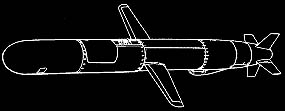
|
NAVAHO: NEW
ROCKET TECHNOLOGIES
| Begun
in 1946, the Navaho was intended to be a supersonic intercontinental-range
ramjet cruise missile. Engineers studied V-2 rocket engines and then
produced an entirely new, more efficient design. Although the Navaho
program was canceled in 1957, it significantly influenced the development
of large liquid-propellant rocket engine technology in the United
States. |
|
TOMAHAWK
| In
the mid-1950s, unpiloted long-range flying bombs still suffered from
insufficient range and accuracy, and they remained easy to shoot down.
By the 1970s, with miniaturization of propulsion, electronics, and
guidance systems, combined with detailed terrain maps from reconnaissance
satellites, the cruise missile became a practical vehicle for conventional
or nuclear weapons. Cruise missiles can be launched from ships, aircraft,
or the ground.
|
|
|
The
Navy's Tomahawk cruise missile (above) was introduced in 1982. It
was used extensively in the 1991 Persian Gulf War.
Gift of
General Dynamics
|

SI#: 97-16272-11 |
 |
| Length: |
5.5 m (18 ft 3
in) |
| Span: |
2.5 m (8 ft 4
in) |
| Weight: |
1,160 kg (2,550
lb) |
| Thrust: |
2,670 newtons
(600 lb) |
| Range: |
Over 2,500 km
(1,550 mi) |
| Manufacturer: |
General Dynamics |
|
|